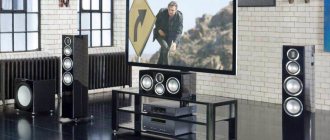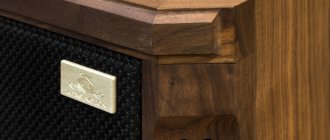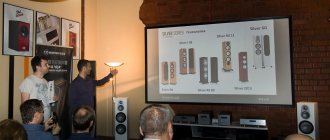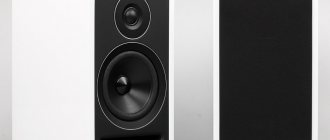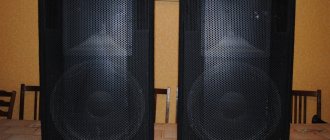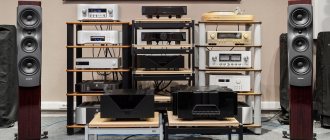The Monitor Audio Gold series of top-end acoustics is not updated often. Just think about it: from 1998 to 2015, only four generations have changed. Purely mathematically, each new version requires almost six years of preparation. True, in fact, previous upgrades took longer, and the new generation appeared only three years after the previous one. What have the engineers managed to do during this time and do the company’s marketers want to sell us the old acoustics in an updated wrapper? When we tested the new Gold 100, by pure chance we were able to compare them directly with the previous Gold GX 100 model. Not just compare, but even measure.
A hundred now and three years ago
The visual differences between Gold GX100 and Gold 100 are small. The most noticeable innovation is the different design of the grills. Previously, they were metal, but now the developers have returned to the classic plastic frame covered with acoustically transparent fabric. Among the decorations is the vintage-looking Monitor Audio logo, which occupies the entire lower edge of the grill. In both cases, fastening is carried out using hidden magnets, so without grills the acoustics look no less neat than with them.
On one side are the Monitor Audio Gold GX100 speakers, and on the other are the Gold 100. Can you spot the main difference (no, it’s not the finish)?
Another obvious difference is the new midrange/woofer cone. Previously, it had pronounced radial ribs, but now in appearance it began to resemble a golf ball. The entire diffuser bowl is covered with small dents of different diameters. Their presence is intended to increase the rigidity of the structure and, if possible, not to distort the main profile of the diffuser. Some other details have also been changed and improved: the magnet has become larger and therefore more powerful, the voice coil is now extended for more stable operation at high loads.
The appearance of the proprietary ribbon tweeter has not changed, there is no detailed information about the improvements, but looking ahead it should be noted that some improvements to the tweeter and crossover definitely took place.
Bookshelf speakers Monitor Audio Gold 100
But what has remained completely unchanged is the body. Gold of the third and fourth generations are identical in this regard. The buildings retained the same shape and proportions. They are made from 20 mm MDF and finished on the outside with natural veneer, tinted in various colors. When touched, veneer creates a feeling of warmth and softness, just like natural wood. The only unpleasant feature is its high sensitivity to mechanical damage. You need to be extremely careful when unpacking and installing, since the coating is easily damaged, and even small scratches on it are clearly visible.
High quality gold
Speaker systems Monitor Audio Gold 100 Price – RUB 129,990.
The history of Monitor Audio Gold Series loudspeakers is long and illustrious. Naturally, the reputable British company did everything to maintain the tradition and build on the success of the previous three “golden” generations. Let's take a closer look and listen to the Monitor Audio Gold 100 bookshelf speaker model.
The Monitor Audio Gold 100 speaker systems are the older of the two bookshelf models in the line (four speakers out of eight for building stereo configurations). According to most specifications, the Gold 100 differs significantly from the oriented stage below the Gold 50. The two-way “hundred” is equipped with two drivers: a 165 mm mid-bass driver and a ribbon tweeter. The first, together with a bass reflex with a HiVe® II rear port, sets the lower limit of the frequency range of 42 Hz (almost extremely deep bass for bookshelf acoustics), the second “shoots” up to space 60 kHz (also a record). The frequency powers of the emitters are delimited by a frequency of 2.7 kHz.
Among the significant design features of the Monitor Audio Gold 100 is the fastening of the woofer/midrange speaker to the rear wall using a single bolt, which makes the structure more rigid and driver vibrations are less transmitted to the body. Monitor Audio Gold 100 implements proprietary patented technologies familiar from other models of the company. C-CAM (Ceramic-Coated Aluminum/Magnesium) indicates the manufacture of midrange/bass driver diffusers from an aluminum-magnesium alloy with a ceramic surface coating. This solution has proven to be effective in achieving the desired balance of high stiffness, low mass and good internal damping of the diaphragms. RST (Rigid Surface Technology) technology is also aimed at maintaining a sufficiently high rigidity, and, consequently, the piston nature of the diffuser’s operation, according to which many spherical recesses of different sizes arranged in concentric rows are extruded onto the surface of the diffuser.
C-CAM and RST are inherited from the previous generations of the line: Gold GR and Gold GS. Of course, in modern “golden” Monitor Audio speakers, these technologies are implemented at a new, higher level. In the context of the differences between today's Gold series speakers and previous ones, the company, among other things, points to tighter tolerances in the production of the ribbon transducer compared to the same ribbon of the Gold GX generation speaker systems. The emitter is structurally similar to that used in the flagship Monitor Audio Platinum line. The manufacturer pays special attention to the selection of pairs of tweeters for speakers, considering this the most important for obtaining high-quality sound.
Among the significant design features of the Monitor Audio Gold 100 is the fastening of the woofer/midrange speaker to the rear wall using a single bolt, which makes the structure more rigid and the vibrations of the moving driver system are less transmitted to the speaker body. Grooves on the bell of the HiVe® II port optimize airflow through the duct, much like the rifling in a gun barrel optimizes bullet movement. Internal signal paths are routed into the speakers using Pureflow® silver cable. The housings of the acoustic systems are made of 20 mm MDF boards and reinforced with radial spacer ribs.
The slight coolness of the tonal balance of the Monitor Audio Gold 100 bookshelf speakers, apparently caused by a small and smooth rise in the HF region, can be easily compensated by turning the speakers slightly towards the side walls. It's a matter of taste...
There are no sharp vertical joints in the columns - the corresponding surfaces smoothly flow into each other through roundings of a small radius. Vertical surfaces are connected to horizontal ones, on the contrary, at right angles. Protective grids for the speakers are conveniently mounted on hidden magnets; The meshes are fabric, unlike the metal ones of Gold GX. The speakers are neatly framed by rings of shiny white metal - there are no fasteners to spoil the look, since the drivers are mounted to the rear wall of the case with a single bolt. Originally - with a vertical shift - two pairs of high-quality screw acoustic terminals for bi-wiring/amping are grouped; The contact parts of the terminals are anodized with gold. Finally, the speakers we tested are immaculately decorated with wood veneer (dark walnut; other finishes offered by Monitor Audio are High Gloss White, Piano Black and Piano Ebony. The latter option costs 20 thousand rubles more). All this undoubtedly determined the high aesthetic advantages of the model and the entire Gold line. It is preferable, first of all, in terms of design, to place monitors on optional branded stands.
Listening to the Monitor Audio Gold 100 gave many reasons to certify the sound quality of the model as very high. The slight coolness of the tonal balance, apparently caused by a small and smooth rise in the high-frequency region, can be easily compensated by turning the speakers slightly towards the side walls. This is a matter of taste - the author of these lines does not consider the above-mentioned feature to be a disadvantage. Frequency bands are perfectly combined within a two-way design, which is especially valuable due to the use of different types of emitters.
Monitor Audio Gold 100 demonstrates a very reliable timbre, perfectly detailed and articulated sound throughout the entire range with a clear, spacious and stable musical scene. This was evidenced, first of all, by the most important tests - recordings of an academic piano and a large symphony orchestra. A good impression was made by the neat - collected, agile, moderately deep bass without a hint of slowness or tonal deviations. A certain lack of low-frequency energy and profundity when playing at significant volumes, for example, recordings of a large cathedral organ or rock compositions with a prominent bass guitar part, can hardly be considered a disadvantage of compact speakers. After all, the Monitor Audio Gold line includes floor-standing speakers.
The sound of the acoustic systems inspires confidence from the very first minutes and does not disappoint subsequently. Monitor Audio Gold 100 - the speakers are not cheap, but their sound is so good that it seems they could cost more. Components of just such a high class comprehensively answer the question “what is real Hi-Fi?”
Invisible bolts
The description of any Monitor Audio series from Bronze to Platinum invariably includes a mention of the proprietary technology for fastening the drivers, with one long bolt passing through the body and attracting the speaker by the magnetic system to the rear wall of the acoustics. The advantages of this solution are obvious: additional tension is created on the case, it becomes possible to organize more effective vibration decoupling from the front panel, and half the load is transferred from the front to the rear wall. In addition, there is an aesthetic advantage. The corporate style of Monitor Audio has become the complete absence of screws on the speaker, as well as the conspicuous large bolt heads on the rear wall. All this is familiar, studied and understood. But on the Gold 100 you can’t immediately see the tie bolts on the back wall.
Bookshelf speakers Monitor Audio Gold 100
The tweeter mounting bolt is hidden from view, since it is not attached to the rear wall of the speaker, but to the internal partition. Its mount can be seen if you look into the bass reflex. And the developers added another useful function to the mid/bass driver bolt - it is the main and only element of fastening the contact pad. Against her background, lost among the terminals, he ceased to be noticeable.
The connection pad itself is distinguished not only by its unusual fastening, but also by the convenient arrangement of the terminals in one line, so that they do not interfere with each other. The jumpers are made of high-quality acoustic cable and have spatula-shaped tips. It looks great, and in principle it’s nice that the manufacturer is concerned about the quality of this element. I don’t even want to switch to bi-wiring or bi-amping after this.
Speaker system Monitor Audio Gold 100 Satin White
The English company Monitor Audio presents the fifth generation of Gold series speaker systems. The Monitor Audio Gold series of top-end acoustics is not updated often. Just think about it: from 1998 to 2019, only five generations have changed. Purely mathematically, each new version requires almost five years of preparation. True, in fact, previous upgrades took longer, and the new generation appeared only three years after the previous one. What have the engineers managed to do during this time and do the company’s marketers want to sell us the old acoustics in an updated wrapper? Naturally, the reputable British company did everything to maintain the tradition and build on the success of the previous four “golden” generations.
Gold 5G acoustics utilize technologies from the flagship speakers of the Platinum II line. For example, RDT II speakers are used in the top-end PL500 II. These drivers feature a custom C-CAM (aluminium-magnesium alloy and ceramic coating) diaphragm, Nomex polymer internal cell structure and a carbon fiber back layer. The new speakers also feature MPD tweeters. The housings are assembled in such a way as to minimize resonances. Finally, the manufacturer focuses on HiVe II bass reflex ports with low turbulence. The Gold 5G line includes six models: Gold 100 bookshelf speakers, Gold C250 center channel speaker, Gold 200 and Gold 300 floor-standing speakers, Gold FX surround channel speaker and Gold W12 active subwoofer. The description of any Monitor Audio series from Bronze to Platinum invariably includes a mention of the proprietary technology for fastening the drivers, with one long bolt passing through the body and attracting the speaker by the magnetic system to the rear wall of the acoustics. The advantages of this solution are obvious: additional tension is created on the case, it becomes possible to organize more effective vibration decoupling from the front panel, and half the load is transferred from the front to the rear wall. In addition, there is an aesthetic advantage. The corporate style of Monitor Audio has become the complete absence of screws on the speaker, as well as the conspicuous large bolt heads on the rear wall. All this is familiar, studied and understood. But on the Gold 100 you can’t immediately see the tie bolts on the back wall.
The tweeter mounting bolt is hidden from view, since it is not attached to the rear wall of the speaker, but to the internal partition.
Its mount can be seen if you look into the bass reflex. And the developers added another useful function to the mid/bass driver bolt - it is the main and only element of fastening the contact pad. Against her background, lost among the terminals, he ceased to be noticeable. The connection pad itself is distinguished not only by its unusual fastening, but also by the convenient arrangement of the terminals in one line, so that they do not interfere with each other. The jumpers are made of high-quality acoustic cable and have spatula-shaped tips. It looks great, and in principle it’s nice that the manufacturer is concerned about the quality of this element. I don’t even want to switch to bi-wiring or bi-amping after this.
The fifth generation Monitor Audio Gold 100 model received an improved ribbon tweeter protected by a metal mesh.
The material used for its membrane is C-CAM, an alloy of magnesium and aluminum coated with ceramics. Such a driver provides accurate sound thanks to an instant response and has an frequency response with an upper limit of 50,000 Hz, which is important for HD audio and recordings on vinyl discs. The bookshelf is equipped with an updated 6.5″ mid/bass driver, which, according to the company, is not inferior in efficiency to a conventional 8-inch driver. The diffuser is made of C-CAM material and has round impressions-recesses (RST technology), which increase its rigidity and prevent deformation. The driver has a dynamic sound and provides deep, well-controlled bass. The emitters are covered with a fabric grill, which is attached to the facade using magnets. From the sound of acoustics with ribbon tweeters, you subconsciously expect something special, bright, and effective. It’s very unusual to see narrow vertical slits instead of the usual round dome - and this requires some kind of justification. However, the first impression of ribbon tweeters is often one of confusion rather than excitement. Everything stays in its place, nothing rings, sticks out and doesn’t bother your ears. In short, the ribbon tweeter does not give any reason to be surprised at anything in particular. But what can you do - this is exactly how acoustics sound with smooth high frequencies.
The fifth-generation Monitor Audio Gold 100 handles the most challenging music material, delivering open, transparent sound with true tones, excellent transient response and deep, fast bass.
The shelf holders can be installed on optional racks. Specifications Monitor Audio Gold 100
Number of bands 2 Number of speakers 2 Housing type bass reflex, port located at the rear, HiVe II technology Tweeter type ribbon tweeter with a membrane made of C-CAM material Diameter and type of midrange/bass driver 6.5″ midrange/bass driver with C-CAM -diffuser and RST technology, cast basket Frequency range 40 Hz – 50 kHz Sensitivity 86 dB (1 W/1 m) Nominal impedance 4 Ohms Maximum sound pressure level 110 dB Power 120 W Recommended amplifier power 60 – 120 W Crossover cutoff frequency 2, 5 kHz Input connectors two pairs of gold-plated screw terminals Fabric grill, removable, magnetic mount Housing dimensions, including terminals (WxHxD) 360 x 195 x 330.6 mm Speaker weight 9.1 kg
Tape focusing
From the sound of acoustics with ribbon tweeters, you subconsciously expect something special, bright, and effective. It’s very unusual to see narrow vertical slits instead of the usual round dome - and this requires some kind of justification. However, the first impression of ribbon tweeters is often one of confusion rather than excitement. Everything stays in its place, nothing rings, sticks out and doesn’t bother your ears. In short, the ribbon tweeter does not give any reason to be surprised at anything in particular. But what can you do - this is exactly how acoustics sound with smooth high frequencies.
Bookshelf speakers Monitor Audio Gold 100
At such moments, it is best to get simpler acoustics from the bins and compare. It has a very sobering effect. C-CAM ribbon tweeters provide a sense of freedom and openness that is extremely rare in traditional dome tweeters. Thanks to the use of a metal membrane as a diffuser, the sound of strings, cymbals and brass is conveyed very naturally, but the sound is not harsh or ringing. At the same time, the acoustics just as successfully convey softer and warmer timbres.
Acoustic tweeter Monitor Audio Gold 100
Well, so that it doesn’t seem like Monitor Audio made the world’s best high-frequency driver and an absolute panacea for all audiophile high-frequency problems, we should add a fly in the ointment to the description. The design of ribbon tweeters in the form of a vertical horn creates an extremely specific dispersion of the upper frequencies, in which even a slight rotation of the acoustics around the vertical axis significantly affects the character of the sound - the scene changes from blurry to clearly focused. The level of output drops significantly when deviating from the axis, and the most complete sound can be achieved only with precise focusing of the radiation at the listening point.
Bookshelf speakers Monitor Audio Gold 100
In the Gold GX100 model this effect was especially pronounced and even with a slight deviation the sound lost its sharpness and brightness, and the scene changed proportions. In the new Gold 100, the developers have clearly worked with dispersion, the negative effect is less pronounced. Strictly on-axis, the sound has become more comfortable, it is less sharp and harsh, but just as detailed and airy. With a slight offset from the axis, the number of top ones does not decrease so sharply, a good level of impact is maintained, and the scene does not lose focus.
The optimal orientation of the radiation axis of Gold 100 tweeters is strictly at the listening point or at a point located directly behind the listener. In this case, the scene is built with a natural ratio of width and depth. Focusing in front of the listener narrows the scene and disproportionately increases depth.
Acoustics test Monitor Audio Gold 100: all that gold that sounds, review. Magazine "Stereo & Video"
The sound, on the one hand, is extremely informative and monitor-like, and on the other hand, it is quite comfortable and natural. The differences between the previous and current generation models are expressed in details that do not change the fundamentally recognizable sound signature of Monitor Audio.
Save and read later -
The Monitor Audio Gold series of top-end acoustics is not updated often. Just think about it: from 1998 to 2015, only four generations have changed. Purely mathematically, each new version requires almost six years of preparation. True, in fact, previous upgrades took longer, and the new generation appeared only three years after the previous one. What have the engineers managed to do during this time and do the company’s marketers want to sell us the old acoustics in an updated wrapper? When we tested the new Gold 100, by pure chance we were able to compare them directly with the previous Gold GX 100 model. Not just compare, but even measure.
A hundred now and three years ago
The visual differences between Gold GX100 and Gold 100 are small. The most noticeable innovation is the different design of the grills. Previously, they were metal, but now the developers have returned to the classic plastic frame covered with acoustically transparent fabric. Among the decorations is the vintage-looking Monitor Audio logo, which occupies the entire lower edge of the grill. In both cases, fastening is carried out using hidden magnets, so without grills the acoustics look no less neat than with them.
On one side are the Monitor Audio Gold GX100 speakers, and on the other are the Gold 100. Can you spot the main difference (no, it’s not the finish)?
Another obvious difference is the new midrange/woofer cone. Previously, it had pronounced radial ribs, but now in appearance it began to resemble a golf ball. The entire diffuser bowl is covered with small dents of different diameters. Their presence is intended to increase the rigidity of the structure and, if possible, not to distort the main profile of the diffuser. Some other details have also been changed and improved: the magnet has become larger and therefore more powerful, the voice coil is now extended for more stable operation at high loads.
The appearance of the proprietary ribbon tweeter has not changed, there is no detailed information about the improvements, but looking ahead it should be noted that some improvements to the tweeter and crossover definitely took place.
Bookshelf speakers Monitor Audio Gold 100
But what has remained completely unchanged is the body. Gold of the third and fourth generations are identical in this regard. The buildings retained the same shape and proportions. They are made from 20 mm MDF and finished on the outside with natural veneer, tinted in various colors. When touched, veneer creates a feeling of warmth and softness, just like natural wood. The only unpleasant feature is its high sensitivity to mechanical damage. You need to be extremely careful when unpacking and installing, since the coating is easily damaged, and even small scratches on it are clearly visible.
Invisible bolts
The description of any Monitor Audio series from Bronze to Platinum invariably includes a mention of the proprietary technology for fastening the drivers, with one long bolt passing through the body and attracting the speaker by the magnetic system to the rear wall of the acoustics. The advantages of this solution are obvious: additional tension is created on the case, it becomes possible to organize more effective vibration decoupling from the front panel, and half the load is transferred from the front to the rear wall. In addition, there is an aesthetic advantage. The corporate style of Monitor Audio has become the complete absence of screws on the speaker, as well as the conspicuous large bolt heads on the rear wall. All this is familiar, studied and understood. But on the Gold 100 you can’t immediately see the tie bolts on the back wall.
Bookshelf speakers Monitor Audio Gold 100
The tweeter mounting bolt is hidden from view, since it is not attached to the rear wall of the speaker, but to the internal partition. Its mount can be seen if you look into the bass reflex. And the developers added another useful function to the mid/bass driver bolt - it is the main and only element of fastening the contact pad. Against her background, lost among the terminals, he ceased to be noticeable.
The connection pad itself is distinguished not only by its unusual fastening, but also by the convenient arrangement of the terminals in one line, so that they do not interfere with each other. The jumpers are made of high-quality acoustic cable and have spatula-shaped tips. It looks great, and in principle it’s nice that the manufacturer is concerned about the quality of this element. I don’t even want to switch to bi-wiring or bi-amping after this.
Tape focusing
From the sound of acoustics with ribbon tweeters, you subconsciously expect something special, bright, and effective. It’s very unusual to see narrow vertical slits instead of the usual round dome - and this requires some kind of justification. However, the first impression of ribbon tweeters is often one of confusion rather than excitement. Everything stays in its place, nothing rings, sticks out and doesn’t bother your ears. In short, the ribbon tweeter does not give any reason to be surprised at anything in particular. But what can you do - this is exactly how acoustics sound with smooth high frequencies.
Bookshelf speakers Monitor Audio Gold 100
At such moments, it is best to get simpler acoustics from the bins and compare. It has a very sobering effect. C-CAM ribbon tweeters provide a sense of freedom and openness that is extremely rare in traditional dome tweeters. Thanks to the use of a metal membrane as a diffuser, the sound of strings, cymbals and brass is conveyed very naturally, but the sound is not harsh or ringing. At the same time, the acoustics just as successfully convey softer and warmer timbres.
Acoustic tweeter Monitor Audio Gold 100
Well, so that it doesn’t seem like Monitor Audio made the world’s best high-frequency driver and an absolute panacea for all audiophile high-frequency problems, we should add a fly in the ointment to the description. The design of ribbon tweeters in the form of a vertical horn creates an extremely specific dispersion of the upper frequencies, in which even a slight rotation of the acoustics around the vertical axis significantly affects the character of the sound - the scene changes from blurry to clearly focused. The level of output drops significantly when deviating from the axis, and the most complete sound can be achieved only with precise focusing of the radiation at the listening point.
Bookshelf speakers Monitor Audio Gold 100
In the Gold GX100 model this effect was especially pronounced and even with a slight deviation the sound lost its sharpness and brightness, and the scene changed proportions. In the new Gold 100, the developers have clearly worked with dispersion, the negative effect is less pronounced. Strictly on-axis, the sound has become more comfortable, it is less sharp and harsh, but just as detailed and airy. With a slight offset from the axis, the number of top ones does not decrease so sharply, a good level of impact is maintained, and the scene does not lose focus. The optimal orientation of the radiation axis of Gold 100 tweeters is strictly at the listening point or at a point located directly behind the listener. In this case, the scene is built with a natural ratio of width and depth. Focusing in front of the listener narrows the scene and disproportionately increases depth.
Bass outline
The low-frequency range of the Gold 100 is reproduced right up to deep bass, but its level is noticeably weakened in comparison with the fairly weighty mid-bass and confident upper bass. If the Gold GX100 seemed more thorough in terms of reproducing deep notes, the new generation sounded clearer and more collected, as well as a little richer in timbre.
Branded mid/bass speaker of the Monitor Audio Gold 100 speaker
Both the previous and current generations of the Gold series have a proprietary HiVeII bass reflex, which has pronounced longitudinal grooves running along its entire length. The HiVeII bass reflex does not create a clearly identifiable boom or prolongation of bass notes. It is tuned quite low, so those who like the sound of a closed cabinet will not lose much in terms of the fullness and integrity of the bass.
Comfortable monitoring
In general, the sound character of Monitor Audio Gold of both generations is very similar. The sound, on the one hand, is extremely informative and monitor-like, and on the other hand, it is quite comfortable and natural. The differences between the previous and current generation models are expressed in details that do not change the fundamentally recognizable sound signature of Monitor Audio.
Bookshelf speakers Monitor Audio Gold 100
In the low-frequency range, the Gold GX100 is a little more solid and fundamental, and the new Gold 100 sounds a little lighter, but at the same time more accurate. The mids and tops of the new Gold 100 are softer and more comfortable. Overall, it feels like the new Gold 100s sound a little more musical without sacrificing the precision and openness that are the core strengths of the Gold series.
Technical commentary on Monitor Audio Gold 100 measurements
The frequency response of Gold 100 is close to linear with a characteristic dip in the 2-3 kHz region and a rise in the 5 kHz region, allowing you to combine naturalness and expressiveness with high detail. A significant loss of output at high frequencies occurs only with a significant deviation from the axis. The frequency response of the previous Gold GX100 model generally has similar features, but the slope is more pronounced in the lower mids and upper bass areas. The level of the upper ones is too high when measured on the axis and drops significantly even with a small deviation.
Bookshelf speakers Monitor Audio Gold 100
The level of distortion in both models is approximately the same, with the exception of the lower bass, where the new mid/bass speaker is slightly inferior to the old one. But the impedance data is the opposite. Here the new model is slightly better. Having resonant peaks in the same zones, the impedance of Gold 100 fits into a narrower range of values, that is, it loads the amplifier to a lesser extent. It is noteworthy that for both models the measured level of sensitivity turned out to be higher than declared, which completely coincides with the subjective assessment.
Stereo.ru laboratory data, November, 2015
Monitor Audio Gold 100
Average THD: 100-20000 Hz, 82/88/94 dB, 0.25/0.25/0.27% 40-100 Hz, 82/88/94 dB, 0.73/0.88/1.19 % Sensitivity at 1 kHz - 93.54 dB Lower cut-off frequency (-10 dB) - 59 Hz
Frequency response graph of Monitor Audio Gold 100 acoustics
Frequency response unevenness: 100 Hz - 20 kHz - +/- 1.42 dB 160 Hz - 1300 Hz - +/- 0.53 dB 1300 Hz - 20 kHz - +/- 1.44 dB 300 Hz - 5 kHz - +/- 1.93 dB
THD graph of Monitor Audio Gold 100 acoustics
Average unevenness (30 degree angle) - 2.60 dB Imbalance (160 Hz - 1300 Hz) - -0.71 dB Imbalance (1300 Hz - 20 kHz) - -1.76 dB Imbalance (30 degree angle) - -4.56 dB
Monitor Audio Gold 100 speaker impedance graph
Impedance: Standard deviation - 3.91 ohms Average value - 10.04 ohms Maximum value - 18.21 ohms Minimum value - 4.93 ohms
Monitor Audio Gold GX100
Average THD: 100-20000 Hz, 82/88/94 dB - 0.18/0.19/0.24% 40-100 Hz, 82/88/94 dB - 0.47/0.33/0.39 % Sensitivity at 1 kHz - 95.93 dB Lower cut-off frequency (-10 dB) - 58 Hz
Frequency response graph of Monitor Audio Gold GX100 acoustics
Frequency response unevenness: 100 Hz - 20 kHz - +/- 1.43 dB 160 Hz - 1300 Hz - +/- 0.77 dB 1300 Hz - 20 kHz - +/- 1.44 dB 300 Hz - 5 kHz - +/- 1.76 dB
THD graph of Monitor Audio Gold GX100 acoustics
Average unevenness (30 degree angle) - 4.58 dB Imbalance (160 Hz - 1300 Hz) - -0.9 dB Imbalance (1300 Hz - 20 kHz) - -0.02 dB Imbalance (30 degree angle) - -7.22 dB
Monitor Audio Gold GX100 impedance graph
Impedance: Standard deviation - 4.40 ohms Average value - 10.66 ohms Maximum value - 20.91 ohms Minimum value - 5.04 ohms
Specifications for the Monitor Audio Gold 100 acoustics
Frequency range - 42-60,000 Hz Configuration - 2-way Crossover frequency - 2.7 kHz HF speaker - ribbon, with a dome cone C-CAM Midrange/bass speaker - 165 mm C-CAM Acoustic design - Bass reflex Sensitivity - 88 dB Impedance — 8 Ohm Input power — 60-120 W Dimensions — 362x210x303 mm Weight — 9.9 kg
Prepared based on materials from the magazine “Stereo & Video”, December 2015.
www.stereo.ru
This review was read 5,810 times
Bass outline
The low-frequency range of the Gold 100 is reproduced right up to deep bass, but its level is noticeably weakened in comparison with the fairly weighty mid-bass and confident upper bass. If the Gold GX100 seemed more thorough in terms of reproducing deep notes, the new generation sounded clearer and more collected, as well as a little richer in timbre.
Branded mid/bass speaker of the Monitor Audio Gold 100 speaker
Both the previous and current generations of the Gold series have a proprietary HiVeII bass reflex, which has pronounced longitudinal grooves running along its entire length. The HiVeII bass reflex does not create a clearly identifiable boom or prolongation of bass notes. It is tuned quite low, so those who like the sound of a closed cabinet will not lose much in terms of the fullness and integrity of the bass.
Comfortable monitoring
In general, the sound character of Monitor Audio Gold of both generations is very similar. The sound, on the one hand, is extremely informative and monitor-like, and on the other hand, it is quite comfortable and natural. The differences between the previous and current generation models are expressed in details that do not change the fundamentally recognizable sound signature of Monitor Audio.
Bookshelf speakers Monitor Audio Gold 100
In the low-frequency range, the Gold GX100 is a little more solid and fundamental, and the new Gold 100 sounds a little lighter, but at the same time more accurate. The mids and tops of the new Gold 100 are softer and more comfortable. Overall, it feels like the new Gold 100s sound a little more musical without sacrificing the precision and openness that are the core strengths of the Gold series.
Technical commentary on Monitor Audio Gold 100 measurements
The frequency response of Gold 100 is close to linear with a characteristic dip in the 2-3 kHz region and a rise in the 5 kHz region, allowing you to combine naturalness and expressiveness with high detail. A significant loss of output at high frequencies occurs only with a significant deviation from the axis. The frequency response of the previous Gold GX100 model generally has similar features, but the slope is more pronounced in the lower mids and upper bass areas. The level of the upper ones is too high when measured on the axis and drops significantly even with a small deviation.
Bookshelf speakers Monitor Audio Gold 100
The level of distortion in both models is approximately the same, with the exception of the lower bass, where the new mid/bass speaker is slightly inferior to the old one. But the impedance data is the opposite. Here the new model is slightly better. Having resonant peaks in the same zones, the impedance of Gold 100 fits into a narrower range of values, that is, it loads the amplifier to a lesser extent. It is noteworthy that for both models the measured level of sensitivity turned out to be higher than declared, which completely coincides with the subjective assessment.
Stereo.ru laboratory data , November, 2015
